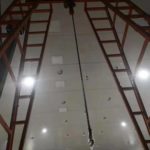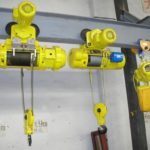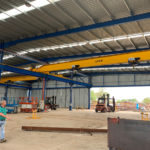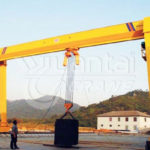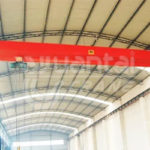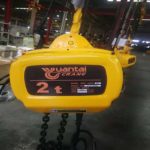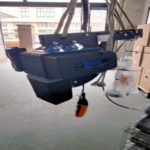We recently shipped 10 sets of electric hoists to Laos, and summarized the points of customer concern. If the electric hoist encounters the following five situations, it needs to stop operating:
- The binding is not firm or unbalanced and may slide, and there is no padding between the corners of the heavy object and the wire rope;
- The structure or components have defects or damages that affect safe work, such as brake safety device failure, hook nut anti-loosening device damage, wire rope damage reaching the scrapping standard, etc.
- Overloading or unclear object weight, such as lifting buried straight objects with unclear lifting weight or pulling force, and cable-stayed and inclined hanging, etc.
- There are people or floating objects on the suspended object
- The working site is dim, and it is impossible to see the site, the situation of the suspended objects and the command signal.
The precautions for the use of wire rope electric hoists are as follows:
- Please never lift objects with a wire rope electric hoist that exceeds the rated load. The rated load is marked on the nameplate of the lifting hook.
- It is forbidden to take people on the lifting object, and absolutely do not use the electric hoist as the lifting mechanism of the elevator to carry people.
- There should be no people or important equipment under the lifting object.
- Lifting objects and hooks cannot be lifted in a swinging state.
- Please move the gourd to the top of the object before hoisting, and do not pull it obliquely or crookedly.
- The limiter is not allowed to be used repeatedly as a travel switch.
- Do not lift objects connected to the ground or buried objects.
- Please do not over-jog to operate the wire rope electric hoist.
- Do not pull other objects forward with the flashlight door wire.
- Be sure to cut off the power supply before maintenance and inspection.
- Maintenance and inspection work must be carried out under no-load conditions.
- Please confirm whether the wedge is installed firmly and reliably before use.
The safety operation specifications in the use of electric hoists include the inspection before use, some matters to be noticed during use, and a series of procedures after the work is completed.
- Before hoisting, check the mechanical parts of the equipment. Steel wire ropes, hooks, stoppers, etc. should be in good condition. Check that there is no leakage in the electrical parts, and the grounding device should be in good condition. Every time when lifting heavy objects, stop the machine 10cm above the ground to check the braking condition, and start working after confirming that it is intact. Outdoor operations should be provided with rainproof sheds.
- It is not allowed to overload the lifting, and the hands are not allowed to be held between the rope and the object when lifting. When the hanging object rises, it is strictly prohibited to collide.
- The lifting objects should be tied firmly and at the center of gravity. When hoisting and walking, the heavy objects should not be too high from the ground. It is strictly forbidden for heavy objects to pass over people’s heads, and it is not allowed to hang heavy objects in the air during work intervals.
- If the electric hoist has a peculiar smell during the hoisting process, if the temperature is high, stop the machine immediately for inspection, find out the cause, and continue working after treatment.
- The wire rope of the electric hoist should be wound neatly on the drum. When the hook is placed at a low position, the wire rope on the drum should not be less than three turns.
- Use the suspension cable electric switch to start, the insulation must be good, the sliding must be free, and the button must be operated correctly and the standing position of the person should be paid attention to.
- During hoisting, when a heavy object falls due to a fault, emergency measures must be taken to lower the heavy object to a place where there is no one there.
- Lifting heavy objects must be lifted vertically. It is not allowed to pull heavy objects obliquely.
- After the work is completed, the electric hoist should stop at the designated position, the hook should be raised, and the power supply should be cut off.
